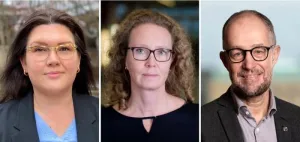(Press-News.org) Remember #BabyShark? And no, this was not the very catchy song for kids that took the internet by storm. Earlier this year, social media was abuzz with stunning footage of a newborn great white shark, captured by a flying drone.
Now, marine scientists have shown for the first time that juvenile great white sharks select warm and shallow waters to aggregate within one kilometer from the shore. These results, published in Frontiers in Marine Science, are important for conservation of great white sharks – especially as ocean temperatures increase due to climate change – and for protecting the public from negative shark encounters.
Nurseries off central California
Baby great white sharks (‘pups’) don’t receive any maternal care after birth. In the studied population off Padaro Beach near Santa Barbara in central California, pups and juveniles gather in ‘nurseries’, unaccompanied by adults.
“This is one of the largest and most detailed studies of its kind. Because around Padaro Beach, large numbers of juveniles share near-shore habitats, we could learn how environmental conditions influence their movements,” said senior author Dr Christopher Lowe, a professor at California State University.
“You rarely see great white sharks exhibiting this kind of nursery behavior in other locations.”
In 2020 and 2021, Lowe and his team used darts to tag a total of 22 juveniles with sensor-transmitters. These were females and males aged between one and six years old. Great white sharks can live for up to 40 to 70 years.
The sensor-transmitters measured local water pressure and temperature in real time, and tracked each juvenile’s position by sending acoustic ‘pings’ into an array of receivers, spread out over approximately 5.5 sq km along the shoreline. These methods had been approved by the university’s Animal Care and Use Committee and California’s Department of Fish and Wildlife.
Tracking was halted during the winter months, when juveniles temporarily left for offshore waters. The researchers gathered further data on the temperature distribution throughout the local water column with an autonomous underwater vehicle. They then used artificial intelligence to train a 3D model of the juveniles’ temperature and depth preferences.
The results showed that the juveniles dived to the greatest depths around dawn and dusk, when they were likely foraging on skates, rays, schooling fish, and other small bony fish. They moved closest to the surface – between zero and four meters deep – in the afternoon when the sun was hottest, possibly to increase their body temperature.
First author Emily Spurgeon, a former master’s student and current research technician in Lowe’s team, said: “We showed that juveniles directly altered their vertical position in the water column to stay between 16 and 22 °C, and if possible between 20 and 22 °C. This may be their optimum to maximize growth efficiency within the nursery.”
Preference for shallow waters
The results showed that the temperature distribution in these waters is ever changeable, which means that juveniles have to be constantly on the move to remain within this optimal range.
The authors concluded that juvenile great white sharks spend most of their time in much shallower water than adults. The latter were rarely observed in the nursery.
The results also showed that the temperature distribution across three dimensions strongly impacted the horizontal distribution of the juveniles, which spread out at greater depths when seafloor temperatures were higher, and moved closer together towards the surface when deeper water was cooler.
What the researchers don’t yet know is what benefits pups and juveniles get from gathering in nurseries in the first place. One advantage might be to avoid predators.
“Our results show that water temperature is a key factor that draws juveniles to the studied area. However, there are many locations across the California coast that share similar environmental conditions, so temperature isn’t the whole story. Future experiments will look at individual relationships, for example to see if some individuals move among nurseries in tandem,” said Spurgeon.
END
Baby sharks prefer being closer to shore, show scientists
Young great white sharks gather in nurseries close to shore, perhaps to avoid predators
2024-04-19
ELSE PRESS RELEASES FROM THIS DATE:
UBC research helps migrating salmon survive mortality hot-spot
2024-04-19
When Kevin Ryan and the other hardworking volunteers at Mossom Creek Hatchery in Port Moody, B.C. release young coho smolts into the ocean, they’re never quite certain how many will return as adults.
Mossom releases between 5,000 and 10,000 coho smolts each year, and is one of the few hatcheries to release coho directly into the ocean, rather than into a river. Until now, no research had looked at the success of direct ocean releases of coho.
UBC researchers used acoustic telemetry to tag and track coho on their journey. The results were revealing: ...
Technical Trials for Easing the (Cosmological) Tension
2024-04-19
Thanks to the dizzying growth of cosmic observations and measurement tools and some new advancements (primarily the “discovery” of what we call dark matter and dark energy) all against the backdrop of General Relativity, the early 2000s were a time when nothing seemed capable of challenging the advancement of our knowledge about the cosmos, its origins, and its future evolution.
Even though we were aware there was still much to uncover, the apparent agreement between our observations, calculations, and theoretical framework was indicating that our knowledge of the universe was set to grow significantly and without ...
Mapping plant functional diversity from space: HKU ecologists revolutionize ecosystem monitoring with novel field-satellite integration
2024-04-19
An international team of researchers, led by Professor Jin WU from the School of Biological Sciences at The University of Hong Kong (HKU), has made a promising advancement in mapping plant functional traits from space using time-series satellite data. The study, published in Remote Sensing of Environment, showcases the innovative combination of the Sentinel-2 satellite mission and its dynamic time-series capabilities. This innovative approach not only unlocks a deeper understanding of essential foliar traits, providing crucial insights ...
Lightweight and flexible yet strong? Versatile fibers with dramatically improved energy storage capacity
2024-04-19
The latest wearable devices, such as Samsung's Galaxy Ring and Apple's Vision Pro, are taking healthcare a step further and even enabling people to work virtually. Given the characteristics of wearable devices that require them to be small and lightweight, there is an inevitable limitation on battery capacity, still presenting a technical barrier to incorporating a variety of functions. In order for wearable devices to fully realize the imagined life, it is necessary to develop a lighter and more fromlessenergy storage method.
The Korea Institute of Science and Technology (KIST) announced that a joint research team led by Dr. Hyeonsu Jeong ...
3 ways to improve diabetes care through telehealth
2024-04-19
Grocery stores, airports and beaches aren’t great places to have telehealth visits with your endocrinologist. But home can be one of the best locations, giving a doctor helpful insights into a patient’s home environment, which can positively impact their care.
This is just one finding shared in a new study published this week in The Journal of Clinical Diabetes.
Researchers interviewed clinicians and staff who provide diabetes care through telehealth across four University of California academic medical ...
A flexible and efficient DC power converter for sustainable-energy microgrids
2024-04-19
A new DC-DC power converter is superior to previous designs and paves the way for more efficient, reliable and sustainable energy storage and conversion solutions. The Kobe University development can efficiently interface with a wide range of energy sources while enhancing system stability and simplicity at an unprecedented efficiency.
Electric power comes in two kinds, AC (alternating current) and DC (direct current). Famously, the question over which kind should be used for national power grids, the “Current War” of the late 19th century, got settled in favor of AC and most power plants today produce ...
Key protein regulates immune response to viruses in mammal cells
2024-04-19
Researchers have revealed the regulatory mechanism of a specific protein that plays a key role in balancing the immune response triggered by viral infections in mammal cells. These findings could help drive the development of antiviral therapies and nucleic acid medicines to treat genetic disorders.
For cells to protect themselves from viral infections, a series of immune responses typically occur, including programmed cell death called apoptosis and interferon signaling. While apoptosis is a normal process, which occurs with or without the presence ...
Development of organic semiconductors featuring ultrafast electrons
2024-04-19
Professors Kimoon Kim and Ji Hoon Shim along with Dr. Yeonsang Lee from the Department of Chemistry at Pohang University of Science and Technology (POSTECH) and Professor Jun Sung Kim from POSTECH’s Department of Physics and the Center for Artificial Low Dimensional Electronic Systems at the Institute for Basic Science created conducting two-dimensional polymers exhibiting electron mobility comparable to graphene. Their research has been featured in the online edition of Chem, an international chemistry journal.
Graphene, called a ...
Cancer is a disease of aging, but studies of older adults sorely lacking
2024-04-19
A systemic review of the current body of research shows that investigators have inadequately addressed the intersection of aging, health disparities, and cancer outcomes among older adults. This is the conclusion of a new paper published in the Journal of the American Geriatrics Society, and led by Nikesha Gilmore, PhD, a member of Wilmot Cancer Institute at the University of Rochester.
As the population of survivors of cancer 65 and older will likely double in size during the next two decades, the review reveals an urgent need for ...
Dietary treatment more effective than medicines in IBS
2024-04-19
Dietary treatment is more effective than medications in irritable bowel syndrome (IBS). These are the findings of a study conducted at the University of Gothenburg. With dietary adjustments, more than seven out of ten patients had significantly reduced symptoms.
Irritable bowel syndrome (IBS) is a common diagnosis that causes abdominal pain, gas and abdominal bloating, diarrhea, and constipation, in various combinations and with varying degrees of severity.
Treatment often consists of dietary advice such as eating small and frequent meals and avoiding excessive intake of food triggers such as coffee, alcohol and fizzy drinks. Patients may also be given medications to improve specific ...
LAST 30 PRESS RELEASES:
Scientists boost cell "powerhouses" to burn more calories
Automatic label checking: The missing step in making reliable medical AI
Low daily alcohol intake linked to 50% heightened mouth cancer risk in India
American Meteorological Society announces Rick Spinrad as 2026 President-Elect
Biomass-based carbon capture spotlighted in newly released global climate webinar recording
Illuminating invisible nano pollutants: advanced bioimaging tracks the full journey of emerging nanoscale contaminants in living systems
How does age affect recovery from spinal cord injury?
Novel AI tool offers prognosis for patients with head and neck cancer
Fathers’ microplastic exposure tied to their children’s metabolic problems
Research validates laboratory model for studying high-grade serous ovarian cancer
SIR 2026 delivers transformative breakthroughs in minimally invasive medicine to improve patient care
Stem Cell Reports most downloaded papers of 2025 highlight the breadth and impact of stem cell research
Oxford-led study estimates NHS spends around 3% of its primary and secondary care budget on the health impacts of heat and cold in England
A researcher’s long quest leads to a smart composite breakthrough
Urban wild bees act as “microbial sensors” of city health.
New study finds where you live affects recovery after a hip fracture
Forecasting the impact of fully automated vehicle adoption on US road traffic injuries
Alcohol-related hospitalizations from 2016 to 2022
Semaglutide and hospitalizations in patients with obesity and established cardiovascular disease
Researchers ‘listen in’ to embryo-mother interactions during implantation using a culture system replicating the womb lining
How changing your diet could help save the world
How to make AI truly scalable and reliable for real-time traffic assignment?
Beyond fragmented markets: A new framework for efficient and stable ride-pooling
Can shape priors make road perception more reliable for autonomous driving?
AI tracks nearly 100 years of aging research, revealing key trends and gaps
Innovative techniques enable Italy’s first imaging of individual trapped atoms
KIER successfully develops Korea-made “calibration thermoelectric module” for measuring thermoelectric device performance
Diversifying US Midwest farming for stability and resilience
Emphasizing immigrants’ deservingness shifts attitudes
Japanese eels, climate change, and river temperature
[Press-News.org] Baby sharks prefer being closer to shore, show scientistsYoung great white sharks gather in nurseries close to shore, perhaps to avoid predators










